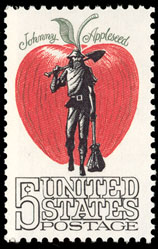The myth and legend of Johnny Appleseed is one that most children growing up in the US have learned. Johnny Appleseed was supposedly a man who wandered the lands west of the 13 colonies planting apple trees all around. Johnny could talk to animals and have them help him on his journeys. Johnny wandered the Midwest wearing a sack and a tin pot for a hat. He was a selfless man who lived a poor, but happy life in harmony with all of nature’s gifts. For a “raw†version of the myth, see the end of this essay for a link to “applejuice.orgâ€â€™s version of Johnny Appleseed. As wild and truly mythical this man’s life sounds, it is surprising how much of it is based on truth.

Johnny Appleseed or John Chapman was thought to be born on Saturday, September 26th, 1774 in Massachusetts.[1] In his early life John studied to be a nurseryman, which is where his famous ability to plant apple orchards was first learned. During his life, the great migration of settlers to the west had begun. The territories to the west were being settled and land grants were given out by the government. Chapman collected seeds from cider presses in Pennsylvania to plant and sell on the frontier.[4] As selfless and not materialistic as the myth makes him out to be, John Chapman was a clever business man who carefully planned out his apple orchard planting. Swedenborg.org’s biography of John Chapman states, “The record on Johnny Appleseed reveals him to be a careful, organized and strategic businessman who, over a period of several decades, bought and sold many dozen tracts of land in advance of the frontier expansion, and who developed countless thousands of productive apple trees throughout the upper Midwest.†[2] Chapman took advantage of the migration to the west by settlers and emigrants by moving ahead of them and planting nurseries. When the settlers and frontiersmen would come by years later, Chapman would return to his nurseries and sell the settlers trees, apples, or seeds, depending on their needs. The more selfless side of Chapman’s history may come from his business relations. Because of his way of life, Chapman could not always collect the debts settlers owed him. He charged the passerby’s whatever they could pay at the time, and if they couldn’t pay him, he would take a note. “He had unusual ideas about charging for his trees and collecting for them. He would take a reasonable price in money, some cast-off clothing, a bit of food, or nothing at all, according to the circumstances of his customer.†[2]
His seemingly selfless demeanor and history may come from his very religious background. Chapman was a Swedenborg Christian man who sometimes thought of himself as a preacher or healer to those on the frontier. His business venture not only supplied him with a means of income, but also a means to help spread his religious beliefs throughout the Midwest. An article in the Boston globe refers to a story of Chapman spreading medicinal herbs and preaching Swedenborg to passing settlers. [3] Swedenborg.org’s biography of Chapman also explains his missionary like lifestyle on the frontier, “In the Mohican country, Johnny visited every cabin religiously, feeling that he had been commissioned to preach, to heal diseases, to warn of danger-in short, to help God take care of the settlers.â€[2] Chapman was a gracious man who traveled the frontier to spread his faith in God and to make a living from selling apple trees. Although it is obvious that Chapman could not talk to animals, he was a man of the wilderness that did not hunt for food. It is noted that he often rescued old, abandoned horses and paid famers he came across to take care of them. [2] Chapman carried few things with him on his journeys, but is often cited carrying his tin pot for cooking.
The toughest part of this myth to bust is most definitely the garb of John Chapman. Unfortunately, no real “primary source†documentation could be found detailing an encounter with Chapman first hand. It is impossible to prove or disprove this part of the legend of Jonny Appleseed without some kind of first-hand account. Overall, it seems many facets of the Johnny Appleseed legend are based on fact, perhaps exaggerated a bit. John Chapman is truly a legend in American history who lived a peculiar life. A short biographical podcast on John Chapman by Profile America said, “Some of his(Chapman’s) trees are still bearing fruit. And Americans do like apples. We each eat nearly 18 pounds of them a year.†John Chapman is a legend who will live in American history long after we finish eating the apples he planted.
Author: Brandon Smith
Works Cited:
[1] “Johnny Appleseed.(Brief biography)(Podcast).” Profile America (US Census Bureau Podcasts) (Sept 26, 2009): NA. General OneFile. Gale. Boston Public Library. 1 Oct. 2009
[2] Johnny Appleseed & Co History. Swedenborg.org, Web. 29 Sep. 2009 <http://www.swedenborg.org/jappleseed/history.html>
[3] Page, Marian. “Jonny Appleseed†Boston Daily Globe 15 May 1912. Pg. 12. Web. 1 Oct. 2009
[4] “Chapman, John.” The Great American History Fact-Finder. Boston: Houghton Mifflin, 2004. Credo Reference. Web. 29 Sep. 2009
“Raw Myth†: http://www.applejuice.org/johnnyappleseed.html

